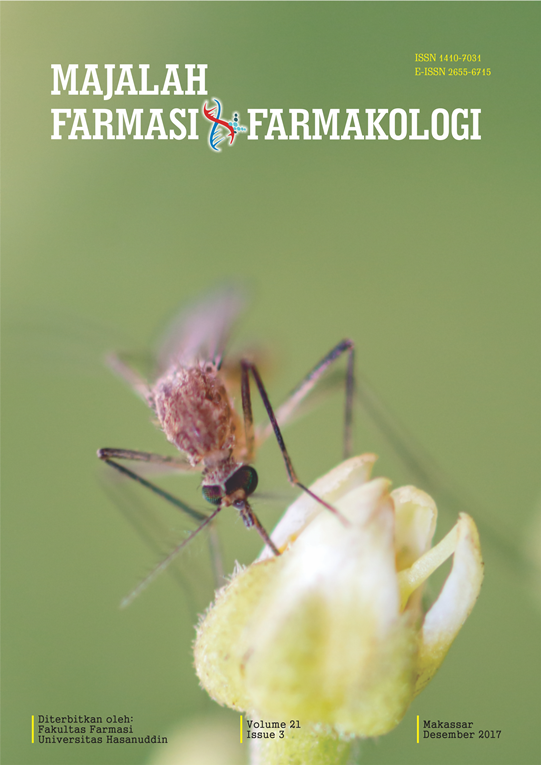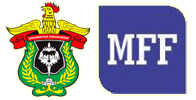ANTI-Plasmodium Berghei EKSTRAK DAUN DAN KAYU Lunasia amara Blanco
Abstract
Lunasia amara Blanco merupakan tumbuhan yang biasa digunakan untuk berbagai penyakit secara empiris termasuk pada gejala malaria. Bagian yang paling banyak digunakan adalah kayu dan batangnya. Berdasarkan informasi tersebut telah dilakukan pengujian ekstrak kayu dan daun dari tanaman sanrego ini terhadap Plasmodium berghei yang diinfeksikan pada tikus sebagai model pengujian awal untuk anti-malaria dari bahan alam. Ekstrak kayu dan batang diperoleh dengan menggunakan penyari methanol secara sonikasi. Berbagai konsentrasi digunakan secara peroral pada mencit yang telah terinfeksi oleh P. berghei selama 5 hari menunjukkan ekstrak daun tidak memiliki kemampuan dalam menurunkan parasetemia pada tikus sedangkan ekstrak batang memiliki kemampuan dalam menghambat parasitemia pada konsentrasi 0,5% dengan nilai dosis supresi 50% (SD50) sebesar 595 mg/kg bobot badan mencit. Hal ini menunjukkan bahwa ekstrak kayu sanrego memiliki kemampuan untuk digunakan sebagai bahan obat untuk pengobatan malariaReferences
Kumala P. Kamus saku kedokteran, dorland. Ed 25. Jakarta: Penerbit Buku Kedokteran EGC; 1998. Malaria, 645
Syarif A dan DS Zunilda. Kemoterapi parasit. Di dalam: Gunawan SG, editor. Farmakologi dan terapi. Ed 5. Jakarta: Bagian Farmakologi. FK-UI; 2007, 556
Price SA, Wilson LM. Patofisiologi, konsep klinis proses-proses penyakit. Ed 6. Jakarta: Penerbit Buku Kedokteran. EGC; 2005: 1. 258
Autino B, Noris A, Russo R, Castelli F, Epidemiology of Malaria in Endemic Areas, Mediterr J Hematol Infect Dis 2012; 4, 1-11
Achan J., Talisuna AO, Erhart A, Yeka A, Tibenderana JK, Baliraine FN, Rosenthal FJ., D’Alessandro U. Quinine, an old anti-malarial drug in a modern world: role in the treatment of malaria. Malaria Journal 2011, 10,144, 1-12
Brown, G.D. Artemisinin and a new generation of antimalarial drugs. Education in Chemistry, 2006, 43 (4). pp. 97-99.
Cahyaningsih R., Characterization of phenotypic diversity of a medicinal plant Lunasia amara. Nusantara Bioscience. 8 (2), 245-251.
Takahashi N, Subehan, Kadota S, Tezuka Y. Mechanism-based CYP2D6 inactivation by acridone alkaloids of Indonesian medicinal plant Lunasia amara. Fitoterapi 2012. 83(4). 774-779.
Nurbita. Uji Daya Hambat Ekstrak Metanol Batang Kayu Sanrego (Lunasia amara Blanco) Terhadap Bakteri Gram Postif (+) dan Gram Negatif (-). Skripsi Jurusan Farmasi Fakultas. MIPA Universitas Hasanuddin. Ujung Pandang. 1994. hal. 29
Arnida. Isolasi Fraksi Aktif Afrodisiaka dari Kayu Sanrego (Lunasia amara Blanco.) pada Tikus Jantan. Majalah Farmasi Indonesia. 2003. Hal. 195.
Subehan, Takahashi N, Kadota S, Tezuka Y. Cytochrome P450 2D6 inhibitory constituents of Lunasia amara. Phytochemistry Letters 2011, 4 (1), 30-33.Schug S.A., Manopas A. (2015), Update on the Role of Non-Opioids for Postoperative Pain Treatment, B est Practice & R esearch Clinical A naesthesiology, Vol. 21 No. 1:15-30.
Downloads
Published
Issue
Section
License
The copyright to this article is transferred to Universitas Hasanuddin (UNHAS) if and when the article is accepted for publication. The undersigned hereby transfers all rights in and to the paper including without limitation all copyrights to UNHAS. The undersigned hereby represents and warrants that the paper is original and that he/she is the author of the paper, except for material that is clearly identified as to its original source, with permission notices from the copyright owners where required. The undersigned represents that he/she has the power and authority to make and execute this assignment.
We declare that:
- This paper has not been published in the same form elsewhere.
- It will not be submitted anywhere else for publication prior to acceptance/rejection by this Journal.
- A copyright permission is obtained for materials published elsewhere and which require this permission for reproduction.
Furthermore, I/We hereby transfer the unlimited rights of publication of the above-mentioned paper in whole to UNHAS The copyright transfer covers the exclusive right to reproduce and distribute the article, including reprints, translations, photographic reproductions, microform, electronic form (offline, online) or any other reproductions of similar nature.
The corresponding author signs for and accepts responsibility for releasing this material on behalf of any and all co-authors. This agreement is to be signed by at least one of the authors who have obtained the assent of the co-author(s) where applicable. After submission of this agreement signed by the corresponding author, changes of authorship or in the order of the authors listed will not be accepted.


